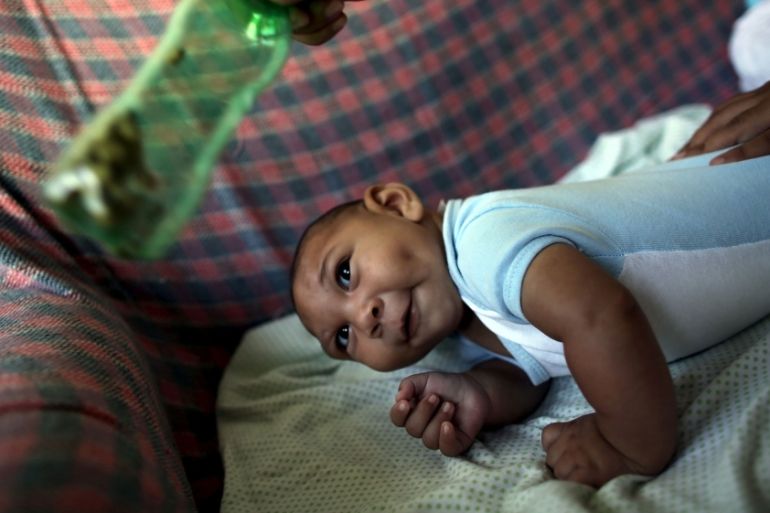World looks for Zika cure as India sees another outbreak
After a new outbreak of the Zika virus in India, the World Health Organization wants to improve its detection.

At least 80 people in India have been infected with the Zika virus, which is potentially dangerous for pregnant women and their fetuses.
According to the Indian government, nearly two dozen of those infected are pregnant women. Zika can sometimes cause babies to develop microcephaly, a brain defect where an infant’s head is smaller than normal.
Keep reading
list of 4 itemsFirst pig kidney in a human: Is this the future of transplants?
Why are some countries decriminalising drugs?
‘No good evidence’ for gender care for youth over long-term, review finds
To prevent further spread of the virus, 330 special teams have been spraying and fumigating houses in the western state of Rajasthan.
India, where the Aedes aegypti mosquito – which carries Zika and other viruses – is widely prevalent, reported its first Zika cases in January 2017 in Rajasthan’s neighbouring Gujarat province.
“Awareness is key in controlling vector-borne diseases. No stone should be left unturned to reach out to the people,” Indian Health Minister J P Nadda said in a statement.
In total, more than 1.5m people worldwide have been infected by the disease globally, most of them in South America.
Currently, there is no cure for the virus, and the World Health Organization (WHO) does not expect one to be released until 2020 at the earliest.
On top of that, detecting Zika infections is really hard for a number of reasons.
What is Zika exactly and why is it hard to detect?
When the Zika epidemic was at its height in the Americas two years ago, diagnostics makers began working feverishly to create diagnostic tests for a virus that few had heard of.
Those efforts have now largely stalled, as public concern has waned, health experts say, and development of inexpensive tests that can quickly detect Zika infections and distinguish them from similar mosquito-borne diseases remains elusive.
A lack of testing capacity has hampered efforts to track Zika in Angola, where a largely unreported cluster of microcephaly cases has been linked to the virus and left mothers vulnerable to an illness that can cause severe birth defects in developing fetuses.
Between February 2017 and May 2018, at least 72 babies with microcephaly were born in the country, an extraordinarily high number compared to earlier years, leading the WHO to link the high number to a Zika outbreak in early 2017.
Why is it hard to test for Zika?
The best and easiest way to detect a Zika infection is to test for the virus while a person is still symptomatic.
This is done through molecular tests which look for genetic material from the virus. Such tests have a very short window and must be done during the 7 to 14 days when the virus is active.
Given that Zika typically causes only mild illness, or no symptoms at all, many people who have been infected miss this critical window.
After the acute infection passes, doctors use so-called serology tests, which sample blood or plasma for antibodies produced in response to the virus.
The drawback with these tests is that Zika is very similar to dengue and other viruses in the same family that are also endemic to tropical regions. Antibodies made in response to these infections can cross-react, producing false positive results.
Because of the potential for cross-reactivity, positive serology results are tested again with a more sensitive, confirmatory test called a plaque reduction neutralization test or PRNT.
Such tests are labour-intensive and only performed by select public health laboratories.
Why is it important to detect Zika?
Dr Eve Lackritz, who leads the Zika Task Force at the WHO, says promoting better diagnostics is a top priority to help track the spread of the virus and develop vaccines.
WHO convened a meeting on diagnostics in Geneva last week with global public health officials, test makers and funding agencies.
“This is not the time to step away,” Lackritz said in an interview with Reuters news agency. “We will see growing populations of susceptible people who can get infected.”
Better tests are needed to check women, especially those who are asymptomatic, during pregnancy, she said. That would include tests to distinguish Zika from other, similar viruses.
Another need is for quick, inexpensive tests that could be used easily in a doctor’s office in developing countries.
Where are we now?
Nearly two dozen manufacturers responded to WHO’s call in 2016 to develop Zika tests. By 2017, the US Food and Drug Administration had granted special emergency use approval to 19 diagnostic tests.
The designation allowed several companies to sell their tests without a full review of their effectiveness.
“They got to a certain point, but didn’t get actual regulatory approval,” said Maurine Murtagh, a former director of diagnostic services for the Clinton Health Access Initiative. The absence of a large outbreak and waning support from funding agencies has removed a lot of the incentive for companies to press on, she said.
Chembio, maker of one of the rapid Zika tests to receive FDA emergency use authorization, is moving forward with plans to seek full US regulatory approval.
Health authorities in Europe and Brazil have approved a different version of the company’s test.
Chief Executive John Sperzel said that while governments will fund the development and purchase of vaccines in a public health emergency, diagnostics companies rarely see such support. Chembio was one of a handful of companies to get a US grant to work on Zika.
That’s an issue Lackritz is trying to address.
“People need to understand there needs to be market forces to get companies to discover diagnostics,” she said.